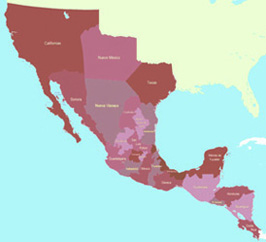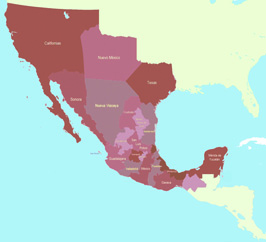
History of Spanish Land Claims in the New World
Mexico has no legal rights to any American or Canadian land
Many Americans and nearly all Mexicans believe the southwest US historically belongs to Mexico. Some Mexicans believe most of the US and parts of Canada really belong to Mexico. These claims are not true. We need to set the record straight on Spanish land claims in the New World.
With the discovery of the New World in 1492 by Christopher Columbus, Spain and Portugal set out to
colonize the entire Western Hemisphere. To prevent conflict between the two countries, Pope Alexander VI issued an edict in 1493, creating a demarcation line 100 leagues west and south of any of the islands of the Azores or the Cape Verde islands. This line gave very little land to Portugal, so the line was moved westward by the Treaty of Tordecillas, signed on June 7, 1494, giving modern day Brazil to Portugal. Spain claimed the right to colonize all of the rest of the Western hemisphere. However, in Spain’s rush to claim this vast amount of land, many of their claims were meaningless. The Spanish became famous for making grandiose claims to land they never stepped foot on, never got close to, often didn’t even know what was there and felt no need to settle.

of the U.S. and parts of Canada historically belongs to
Mexico. This belief is factually wrong.
For instance, in 1513, Vasco Balboa crossed Panama and was the first European to see the Pacific Ocean from the west coast of the New World. With a wave of his arm, Balboa promptly claimed the entire Pacific Ocean and all lands adjoining it for Spain. Although Balboa didn’t know it, he claimed modern day United States, Canada, Alaska, Siberia, Japan, Korea, China, The Philippines, Vietnam, Indonesia, Malaysia, Australia and New Zealand – all for Spain. Spain claimed all islands in the Caribbean although they did not settle all of them and didn’t even know how many were there. In 1775, two Spanish ships sailed up the west coast to Alaska, claiming all land up to Alaska. In 1790, Spanish Explorer Salvador Fidalgo claimed more of Alaska for Spain. During these two expeditions, Spanish names were given to different areas. However, these areas were never settled by the Spanish.
The Spanish grossly over extended themselves. Balboa may as well have claimed the whole world. This claim was meaningless. Unless a country put a sizeable permanent settlement on the land they claimed and could defend it, the claim meant little to nothing. For instance, Spain had a large presence in Cuba, Mexico and other central and south American countries. These were the lands with the gold, silver and other riches that Spanish ships hauled back to Spain. Spain concentrated on these lands and held them.
Spain also claimed land in north America but they never settled them with much more then small, widely scattered villages. The interior lands were mostly unsettled and unexplored. The other world powers had no intentions of allowing Spain to keep land they were not using.
Just as importantly, many lands were claimed by more than one country. The English claimed the land from California to Alaska. Sir Francis Drake claimed the land north of present day San Diego, California for England in 1579. The Russians made the first permanent settlement in Alaska in 1784 and further colonization were carried out until the mid 1800s. The Russians had trading posts as far south as Sonoma County in California, where, in 1812 they built an outpost called Fort Ross. The local Indian tribe, the Kashya Pomo, allowed the Russians to build Fort Ross on condition they protect them from the Spanish, later Mexican troops.(1) In 1836 Mexico establish a military base nearby (called The Sonoma Barracks) to prevent the Russians from expanding any further into the region. In addition, the Spanish launched about 100 expeditions out of Sonoma to subdue the local Indian tribes.(2) The French sent several expeditions through northern California from the late 1700s on.
The deciding factor in all this was who put the most people on their land on a permanent basis. Possession meant ownership. Being first to an area didn’t mean it was yours. Countries that claimed land without having enough people to permanently settle AND HOLD the area made claims of ownership tenuous and your claims were open to challenge.
——————————————————————-
Acquisition of land by the U.S. – the U.S. did NOT steal Mexican land
The Treaty of Paris in 1783 ended the Revolutionary War between the U.S. and Britain. The western boundary became the Mississippi River. Spain controlled the land west of the Mississippi River and Florida.

In 1803, the US bought a huge amount of land from France that became known as the Louisiana Purchase. This land had been under Spanish rule from 1763 until October 1, 1800, when Napoleon persuaded a reluctant King Charles IV of Spain to cede Louisiana back to France.
The Adams-Onis Treaty of 1819 resolved long standing disputes with the US on Spanish claims in North America. Spain gave up all claims north of the 42nd parallel north (northern boundary of present day California), gave Florida to the US and established the Sabine River as the boundary between Texas (then a province of Spain) and Louisiana.
When Mexico gained independence from Spain in 1821, they inherited a huge amount of land north of the Rio Grande, but had hardly anyone to settle there. Although roughly half of Mexico’s land area was north of the present day boundary with the US, only 1% of the population of Mexico lived on this land. Mexico then lost the northern half because they lost wars to Texas in 1836 and then the US in 1846 – wars Mexico started.

In June, 1854, the U.S. acquired the southern third of Arizona and parts of New Mexico, which became known as the Gadsden Purchase. Most Mexicans and many Americans believe that Mexican leader Santa Anna was bullied by the US into selling this land for building a railroad. This is NOT true. Santa Anna wanted to sell this land because he needed money. After Santa Anna received $10 million for this land he stole $700,000 for his personal use and the rest was used to pay off adversaries and allies.(3)(4)(5)
About a year later, Santa Anna tried to sell more land to the U.S. but U.S. officials refused to consider it.
It was really inevitable that Spain/Mexico’s land claims would come into conflict with America’s more limited expansion. While Spain/Mexico was claiming land just to claim it, the US was rapidly expanding based on a growing population.
Although Mexico lost Texas and the southwest US to the US over a century and a half ago, many Mexicans still believe these lands historically belong to Mexico and are holding a grudge against the U.S. The truth is this land historically belongs to the Indians, not the Spanish. The Spanish took this land from the Indians.
Most Mexicans believe that if they had kept ownership of the land north of the Rio Grande – Texas, California, New Mexico, etc., these areas would be economically prosperous like they are now. This is delusional thinking. These areas became prosperous because they belong to the US, not Mexico. Had these lands stayed under the control of Mexico, they would not have helped Mexico prosper. This part of Mexico would be as dysfunctional as the rest of Mexico. All that would change is that constant revolutions, widespread poverty, a disastrous economic system, bad health care, poor education, political turmoil and murderous drug cartels would be in a country twice as large as it is now. Even more illegal immigrants from Mexico would be coming into our considerably smaller country for jobs.

Texas was NOT the first state to secede from Mexico. Because of the dysfunctional state of Mexican politics – and only 2 years after independence, five states in central America declared themselves independent from Mexico – Guatemala, El Salvador, Honduras, Nicaragua and Costa Rica. On July 1, 1823, the United Provinces of Central America was formally established in Guatemala City. The Union fell apart in 1838. The five states became independent nations without any interference from Mexico or threats of perpetual war. So why hasn’t Mexico made an issue out of this over the past 190 years? Is it because they are fellow Spanish, whereas the northern territories came under control of those evil Anglo Americans? Are Mexicans racist? Just wondering.

In conclusion, the U.S. has legal ownership of all U.S. land, including the southwest U.S.
CASE CLOSED.
Sources:
1. Indians, Missionaries, and Merchants by Kent G. Lightfoot. Pub 2005, pg. 156, 157
2. http://www.napanet.net/~sshpa/sbarracks.htm
3. Slavery, Scandal and Steel Rails by David Devine. Pub 2004, p 81
4. Turmoil on the Rio Grande by William S. Kiser. Pub 2011, p 89,90
5. The Gadsden Treaty by Paul Garber. Pub 1923, p 155
June 2022
You may be interested
Slavery and the Founding Fathers
Slavery was NOT an American invention. Virtually every civilizations since...
Manifest Destiny
The term "Manifest Destiny" is usually associated with the territorial...
Mexico’s secret War against the U.S.
1) Mexican claims of land theft by the U.S. are...
Leave a Reply